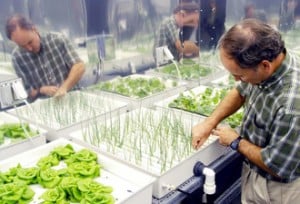In growing food, farmers and homeowners alike often must contend with pesky pest infestations that can present challenges in terms of control. Whether down on the farm, in the community garden or in the yards of homes on the range, pest management techniques can run the gamut, everything from aerial crop-dusting and ground spraying of commercial chemical treatments to insecticides and rodent traps.
Not all pest management practices the same
Inside the 21,000 square-foot greenhouse housing the hydroponics operation of SLO Grown Produce located in Arroyo Grande, California, crop/plant infestations are kept in check using a number of biological methods.

The leaves of cucumbers, eggplants, peppers, tomatoes as well as five basil varieties are the target of the damaging aphid species. To control these, a number of bio-control methods are employed. Among those effective control solutions is parasitization.
One kind of parasitization involves the use of a type of wasp which lays eggs, the larvae of which eat the plant-attacking aphids. In the video production: “SLO County Farmers Market Special Presentation, Hydroponic Farming, Featuring SLO Grown Produce, Arroyo Grande, California,”1 SLO Grown Produce principal Philip Langston explains: “The little wasp lays its eggs in the aphid and then the developing wasp lives inside the aphid and then hatches out and leaves the aphid killing the aphid in the process.” Predatory insects, meanwhile, such as lady bugs and midges feed on aphids. Ladybug larvae, emphasizes Langston, “will eat their weight in aphid a day. They are just incredible eating machines!” (For more on SLO Grown Produce’s hydroponics growing and biological pest control, go here).
In a different location, but also in California, this time in the grape growing and wine making region of Napa Valley, winegrape grower Chris Thorpe deals with problems created by vine mealybugs which can be a real nuisance. To fight these, Thorpe takes a proactive approach on his Adastra Vineyards operation relying on lady bugs and mealybug destroyers (another predatory insect) to keep the mealybugs at bay. But, at the Adastra Vineyards site, the mealybugs have help of their own. They’ve formed a symbiotic relationship with Argentine ants, which actually shield the mealybugs from their natural adversaries.
In the Feb. 2010 Fruit Growers News (FGN) article, “Northern California vineyard reaches for the stars,” Thorpe was quoted as saying: “‘We try to reduce the ant populations with organic poison,’ he said.”2 This effective method saves from having to rely on harmful chemical defenses. (For more on Adastra Vineyards, go here).
Meanwhile, on the Mokichi Okada Association (MOA) International-Fresno farm in California’s Central Valley, besides making use of the ladybug to control insect pests, MOA-Fresno also uses frogs.3 (For more on MOA-Fresno, go here).
And, on one other Central Valley-based farm, T&D Willey Farms in Madera County, it is more of the same. Principal Tom Willey states: “‘We are doing a better job on pest and disease control,’ Tom said. ‘We have fewer critical responses we have to make; we try to stay ahead of the curve. We do a lot of releases of beneficial insects.’”4 (For more on T&D Willey Farms go here).
For each of these growers, it’s all about controlling pests naturally, that is, without harming the environment and what’s in it, except for the crop/plant invasive pests, that is. And, the growers in question probably rest a whole lot easier knowing that this is the case.
Notes
- “SLO County Farmers Market Special Presentation, Hydroponic Farming, Featuring SLO Grown Produce, Arroyo Grande, California,” a Gong About Video production.
- Alan Kandel, “Northern California vineyard reaches for the stars,” Fruit Growers News (FGN), Feb. 2010, p. 46.
- Alan Kandel, “Five-acre California farm offers numerous crops,” The Vegetable Growers News, Sept. 2008, p. 25.
- Alan Kandel, “California grower favors organic practices,” Vegetable Growers News (VGN), Jan. 2009, pp. 16 & 17.
Image above: NASA/Kennedy Space Center
– Alan Kandel
Biological pest control is a great way for pest control this will really help pest control companies to reduce the use of chemicals and this also cut the cost and allows to people get pest control services are very fine cost.